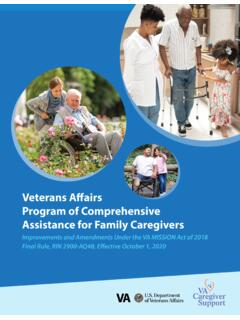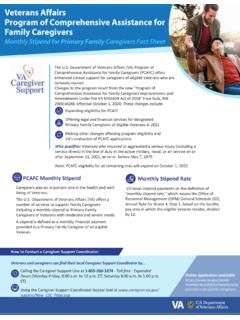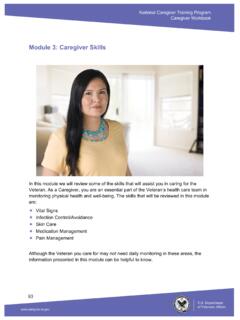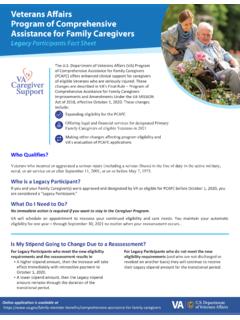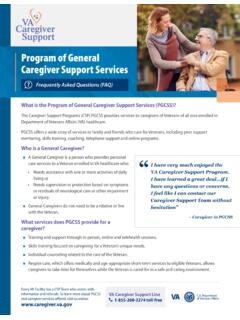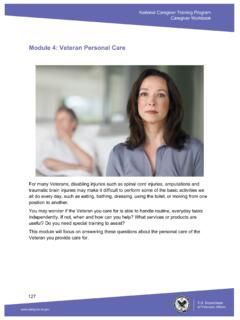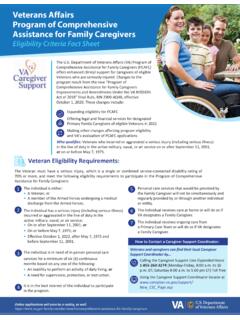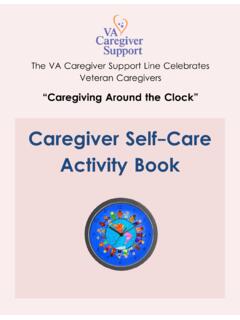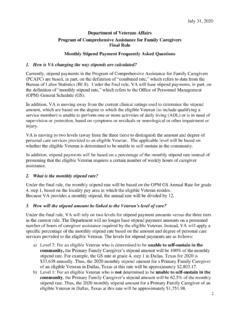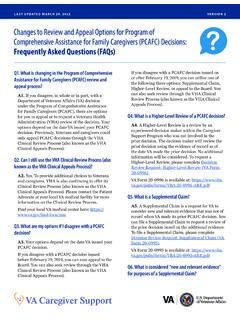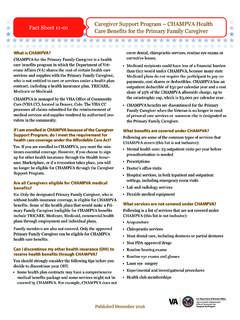Transcription of Veterans Affairs Program of ... - caregiver.va.gov
1 Veterans AffairsProgram of Comprehensive AssistanceFor family CaregiversRoles, Responsibilities and Requirements Fact SheetThe Department of Veterans Affairs (VA) Program of Comprehensive Assistance for family caregivers (PCAFC) is a clinical Program that focuses on the needs of participating Veterans (including qualifying Service members) and their primary and/or Secondary family Caregiver(s). All PCAFC eligibility requirements must be met to be approved for and to continue to participate in PCAFC. This document explains the roles, responsibilities, and requirements of family caregivers and Veterans participating in PCAFC as well as the VA Caregiver Support Program (CSP) CAREGIVERRole A primary family Caregiver is an individual designated as primary provider of personal care services for the Veteran. This individual has been specified on the joint application as the primary family Caregiver and has been approved by VA as the primary family Caregiver for the purposes of Secondary family Caregiver is an individual approved as a provider of personal care services for the Veteran and generally serves as a back-up to the primary family Caregiver.
2 This individual has been specified on the joint application as a Secondary family Caregiver and has been approved by VA as a Secondary family Caregiver for the purposes of encourages both primary and Secondary family caregivers to do the following: Work closely with the Veteran s treatment team to support, promote, and encourage the Veteran in attaining the highest level of independence possible. Notify the Caregiver Support Program (CSP) Team if there is any change to a family Caregiver s address, telephone number or other contact information. VA encourages notification promptly via telephone, in writing or in person, that includes the effective date of the change. Notify the CSP Team if a family Caregiver is no longer willing or able to serve as the Veteran s family Caregiver for any reason, including a change in physical or mental health conditions, impacting their ability to care for the Veteran.
3 Notify the CSP Team and the Veteran s primary care team if a family Caregiver observes any changes in the Veteran s physical or mental health condition impacting the Veteran s care needs. For the primary family Caregiver Only: Notify the CSP Team if the primary family Caregiver is participating in the Civilian health and Medical Program of VA ( champva ) under PCAFC and: Becomes covered under a health -plan contract such as a commercial health insurance plan, Medicare, Medicaid, or a Workers Compensation law or plan. Note: If the primary family Caregiver is covered by a health -plan contract, he or she is not eligible for champva under PCAFC. Becomes eligible for TRICARE. Note: Individuals are not eligible for champva if they are also eligible for TRICARE. Requirements The following are requirements of both primary and Secondary family caregivers : Submit a joint application for the Program of Comprehensive Assistance for family caregivers , VA Form 10-10CG.
4 The family Caregiver applicant(s) and the identified Veteran (or the Veteran s Representative) must sign and date the application. Be at least 18 years of age and agree to perform personal care services for the Veteran. Be a member of the Veteran s family , such as a spouse, son, daughter, parent, step- family member, or extended family member; or if not a member of the Veteran s family , the family Caregiver(s) must live with the Veteran full-time or will do so if designated as a family Caregiver. Complete all necessary eligibility evaluations, caregiver education and training, and the initial home-care assessment so that VA may complete the designation process no later than 90 days after the date the joint application was received by VA. Participate in all reassessments by VA. Reassessments generally occur on an annual basis but may occur more or less frequently as determined appropriate by VA.
5 Reassessments include consideration of whether the Veteran is unable to self-sustain in the community for purposes of the monthly stipend rate. Reassessments may include a visit to the Veteran s home. Participate in wellness contacts. Ongoing wellness contacts will be conducted to review the Veteran s well- being, the adequacy of the personal care services being provided by the family Caregiver(s), and the well-being of the family Caregiver(s). Wellness contacts will occur at a minimum of once every 120 days, and at least one wellness contact must occur in the Veteran s home on an annual basis. VA must be notified of the following: When the Veteran relocates to a new address. Please notify the CSP Team as soon as possible via telephone, in writing, or in person any time the Veteran relocates to a new address and include the new address and the date of the relocation.
6 VA must receive notification no later than 30 days from the date of relocation. If VA does not receive notification within 30 days from the date of relocation, VA will seek to recover overpayments of benefits back to the latest date that the adjustment would have been effective if VA had been notified within 30 days from the date of relocation. If the Veteran or a family Caregiver is institutionalized in a setting outside the home residence to include a hospital, rehabilitation facility, jail, prison, assisted living facility, medical foster home, nursing home, or other similar setting. Please notify the CSP Team as soon as possible via telephone, in writing, or in person any time the Veteran or a family Caregiver is institutionalized. VA must receive notification, no later than 30 days from the date of institutionalization. This notification must include whether the Veteran or family Caregiver is expected to be institutionalized for 90 or more days.
7 Delays in notifying VA of the Veteran s or a family Caregiver s institutionalization, could result in an overpayment of benefits; overpayments are subject to collection action. If the Veteran or another family Caregiver dies. Please notify the CSP Team and the Veteran s primary care team as soon as possible via telephone, in writing, or in person in the event of the Veteran s death or the death of a family Caregiver. VA must receive notification no later than 30 days from the date of death. Delays in notifying VA of a Veteran s death or the death of a primary family Caregiver could result in an overpayment; overpayments are subject to collection RoleFor purposes of this document, a Veteran is an individual who has submitted a joint application for PCAFC participation and for whom a primary and/or Secondary family Caregiver has been approved and designated by VA.
8 The Veteran receives personal care services from the designated family Caregiver(s).Responsibilities VA encourages the Veteran to do the following: Work closely with family Caregiver(s) and primary care team to attain the highest possible level of independence. Notify the Caregiver Support Program (CSP) Team if receiving care from non-VA providers for the purposes of care coordination. Notify the CSP Team if any designated family Caregiver is no longer willing or able to serve as a family Caregiver for any reason including a physical or mental health condition. Requirements The following are the requirements of the Veteran: Submit a joint application for the Program of Comprehensive Assistance for family caregivers , VA Form 10-10CG. The Veteran (or the Veteran s Representative) and the family Caregiver applicant(s) must sign and date the application.
9 Complete all necessary eligibility evaluations and the initial home-care assessment so that VA may complete the designation process no later than 90 days after the date the joint application was received by VA. Receive ongoing care from a primary care team if VA designates a family Caregiver. primary care team means one or more medical professionals who provide care for a patient based on the clinical needs of the patient. primary care teams must include a VA primary care provider who is a physician, advanced practice nurse, or a physician assistant. Receive care at home if VA designates a family Caregiver. Participate in all reassessments. Reassessments generally occur on an annual basis but may occur more or less frequently as determined appropriate by VA. Reassessments include consideration of whether the Veteran is unable to self-sustain in the community for the purposes of the monthly stipend rate.
10 Reassessments may include a visit to the Veteran s home. Participate in wellness contacts. Ongoing wellness contacts will be conducted to review the Veteran s well-being, the adequacy of the personal care services being provided by the family Caregiver(s), and the well-being of the family Caregiver(s). Wellness contacts will occur at a minimum of once every 120 days, and at least one wellness contact must occur in the Veteran s home on an annual basis. VA must be notified of the following: Relocation of the Veteran to a new address. Please notify the CSP Team as soon as possible via telephone, in writing, or in person any time the Veteran relocates to a new address and include the new address and the date of the relocation. VA must receive notification no later than 30 days from the date of relocation. If VA does not receive notification within 30 days from the date of relocation, VA will seek to recover overpayments of benefits back to the latest date that the adjustment would have been effective if VA had been notified within 30 days from the date of relocation.
